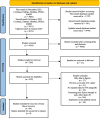Restoring Knee Flexor Strength Symmetry Requires 2 Years After ACL Reconstruction, But Does It Matter for Second ACL Injuries? A Systematic Review and Meta-analysis
- PMID: 38180584
- PMCID: PMC10769975
- DOI: 10.1186/s40798-023-00666-5
Restoring Knee Flexor Strength Symmetry Requires 2 Years After ACL Reconstruction, But Does It Matter for Second ACL Injuries? A Systematic Review and Meta-analysis
Abstract
Background: It is unknown whether knee flexor strength recovers after anterior cruciate ligament (ACL) reconstruction with a hamstring tendon (HT) autograft and whether persistent knee flexor strength asymmetry is associated to a second ACL injury.
Objective: We aimed to systematically review (1) whether knee flexor strength recovers after ACL reconstruction with HT autografts, and (2) whether it influences the association with a second ACL injury. A third aim was to summarize the methodology used to assess knee flexor strength.
Design: Systematic review and meta-analysis reported according to PRISMA.
Methods: A systematic search was performed using the Cochrane Library, Embase, Medline, PEDRo, and AMED databases from inception to December 2021 and until completion in January 2023. Human clinical trials written in English and conducted as randomized controlled trials, longitudinal cohort, cross-sectional, and case-control studies on patients with index ACL reconstructions with HT autografts harvested from the ipsilateral side were considered. Knee flexor strength was measured isokinetically in both the reconstructed and uninjured limb to enable the calculation of the limb symmetry index (LSI). The Risk of Bias Assessment Tool for Non-Randomized Studies was used to assess risk of bias for non-randomized studies and the revised Cochrane Risk of Bias tool was used for randomized controlled trials. For the meta-analysis, the LSI (mean ± standard error) for concentric knee flexor strength at angular velocities of 60°/second (s) and 180°/s preoperatively and at 3 months, 6 months, 12 months, and 24 months were pooled as weighted means with standard errors.
Results: The search yielded 64 studies with a total of 8378 patients, which were included for the assessment of recovery of knee flexor strength LSI, and a total of 610 patients from four studies that investigated the association between knee flexor strength and second ACL injuries. At 1 year after ACL reconstruction, the knee flexor strength LSI had recovered to 89.0% (95% CI 87.3; 90.7%) and 88.3% (95% CI 85.5; 91.1%) for the velocities of 60°/s and 180°/s, respectively. At 2 years, the LSI was 91.7% (95% CI 90.8; 92.6%) and 91.2% (95% CI 88.1; 94.2%), for velocities of 60°/s and 180°/s, respectively. For the association between knee flexor strength and second ACL injuries, there was insufficient and contradictory data.
Conclusions: There was low to very low certainty of evidence indicating that the recovery of knee flexor strength LSI, defined as ≥ 90% of the uninjured side, takes up to 2 years after ACL reconstruction with HT autografts. Whether knee flexor strength deficits influence the association of second ACL injuries is still uncertain. There was considerable heterogeneity in the methodology used for knee flexor strength assessment, which together with the low to very low certainty of evidence, warrants further caution in the interpretation of our results.
Registration number: CRD42022286773.
Keywords: Anterior cruciate ligament; Hamstring tendon autograft; Knee flexor strength; Knee flexor strength methodology; Limb symmetry index; Second ACL injuries.
© 2024. The Author(s).
Conflict of interest statement
The authors declare they have no conflicts of interest relevant to the content of this review.
Figures






Similar articles
-
Comparison of knee flexor strength recovery between semitendinosus alone versus semitendinosus with gracilis autograft for ACL reconstruction: a systematic review and meta-analysis.BMC Musculoskelet Disord. 2024 Feb 12;25(1):136. doi: 10.1186/s12891-024-07226-2. BMC Musculoskelet Disord. 2024. PMID: 38347523 Free PMC article.
-
Knee muscle strength after quadriceps tendon autograft anterior cruciate ligament reconstruction: systematic review and meta-analysis.Knee Surg Sports Traumatol Arthrosc. 2021 Sep;29(9):2918-2933. doi: 10.1007/s00167-020-06311-y. Epub 2020 Oct 7. Knee Surg Sports Traumatol Arthrosc. 2021. PMID: 33026536
-
The NordBord test reveals persistent knee flexor strength asymmetry when assessed two and five years after ACL reconstruction with hamstring tendon autograft.Phys Ther Sport. 2024 Mar;66:53-60. doi: 10.1016/j.ptsp.2024.01.008. Epub 2024 Feb 1. Phys Ther Sport. 2024. PMID: 38330681
-
Autograft type affects muscle strength and hop performance after ACL reconstruction. A randomised controlled trial comparing patellar tendon and hamstring tendon autografts with standard or accelerated rehabilitation.Knee Surg Sports Traumatol Arthrosc. 2021 Sep;29(9):3025-3036. doi: 10.1007/s00167-020-06334-5. Epub 2020 Oct 31. Knee Surg Sports Traumatol Arthrosc. 2021. PMID: 33128587 Free PMC article. Clinical Trial.
-
Quadriceps Tendon Versus Hamstring Tendon Autografts for Anterior Cruciate Ligament Reconstruction: A Systematic Review and Meta-analysis.Am J Sports Med. 2022 Dec;50(14):3974-3986. doi: 10.1177/03635465211033995. Epub 2021 Sep 2. Am J Sports Med. 2022. PMID: 34470509
Cited by
-
Velocity-based training in mid- and late-stage rehabilitation after anterior cruciate ligament reconstruction: a narrative review and practical guidelines.BMJ Open Sport Exerc Med. 2025 Apr 24;11(2):e002503. doi: 10.1136/bmjsem-2025-002503. eCollection 2025. BMJ Open Sport Exerc Med. 2025. PMID: 40297302 Free PMC article. Review.
-
Higher Unilateral Muscle Imbalance at the Contralateral Knee 6 Months after Anterior Cruciate Ligament Reconstruction.Sports (Basel). 2024 Sep 4;12(9):243. doi: 10.3390/sports12090243. Sports (Basel). 2024. PMID: 39330721 Free PMC article.
-
Persistent isokinetic knee flexion strength deficits at the time of return to sport are not associated with a second ACL injury.Knee Surg Sports Traumatol Arthrosc. 2025 Aug;33(8):2971-2983. doi: 10.1002/ksa.12718. Epub 2025 Jun 8. Knee Surg Sports Traumatol Arthrosc. 2025. PMID: 40483729 Free PMC article.
References
Publication types
LinkOut - more resources
Full Text Sources

